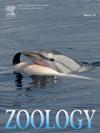zoarcoid鱼类沿身体延伸连续体的隐解剖适应性峰移和过渡
IF 1.6
3区 生物学
Q2 ZOOLOGY
引用次数: 0
摘要
身体伸长是鳍鱼进化的一个主要特征。细长的身体形状在不同的谱系中反复出现,并导致了一系列类似鳗鱼的鱼类的系统发育多样性。尽管整体形状明显趋同,但独立的延伸事件通过骨骼解剖变化的多样性发生,表明潜在的发育、功能和生态变化具有可变性。然而,目前尚不清楚,这种多样性是否表征了谱系在伸长后的进化。在这项研究中,我们表明,即使在硬骨鱼的主要细长辐射中,Zoarcoidei(鳗嘴,刺背等)也发生了各种各样的解剖变化,并且它们与体型表现出复杂的关系。我们测量了14个已知兽类科中12个71个物种的颅骨和轴骨尺寸以及整体体型,并对这些数据进行了多优化适应进化(Ornstein-Uhlenbeck)模型的拟合。我们估计,在大多数世系中,Zoarcoidei保留了一个中等伸长的祖先优化。尽管如此,我们还是确定了三个向高度拉长的身体形状的峰值转移,这在相关的解剖变化中有所不同。此外,我们还发现了多个隐藏的解剖学峰移,其中颅骨和轴向骨骼解剖的转变发生在保留祖先最佳体型的谱系中。总之,我们的研究结果揭示了细长鱼类形态进化的隐藏水平,表明体型的相似性掩盖了不同的生态需求和不同的功能能力。本文章由计算机程序翻译,如有差异,请以英文原文为准。
Cryptic anatomical adaptive peak shifts and transitions along the body elongation continuum in zoarcoid fishes
Body elongation is a major feature of ray-finned fish evolution. Elongate body shapes have arisen repeatedly across lineages and led to a phylogenetically diverse array of eel-like fishes. Despite apparent convergence in overall shape, independent elongation events have occurred through a diversity of skeletal anatomical changes, suggesting variability in underlying developmental, functional, and ecological shifts. It is less clear, however, whether such diversity characterizes evolution in lineages following elongation. In this study, we show that, even within a predominantly elongate radiation of teleost fishes, the Zoarcoidei (eelpouts, pricklebacks, and others), a variety of anatomical shifts have occurred, and they exhibit a complex relationship with body shape. We measured dimensions of the cranial and axial skeleton as well as overall body shape from 71 species representing 12 of 14 recognized zoarcoid families, and we fit multi-optimum adaptive evolutionary (Ornstein-Uhlenbeck) models to these data. We estimated a moderately elongate ancestral optimum for Zoarcoidei that was retained in most lineages. Still, we identified three peak shifts to highly elongate body shapes, which differed in associated anatomical changes. In addition, we detected multiple cryptic anatomical peak shifts in which transitions in cranial and axial skeletal anatomy occurred in lineages that retained the ancestral body shape optimum. Altogether, our results reveal a hidden level of morphological evolution in elongate fishes, suggesting that similarity in body shape belies diverse ecological demands and varied functional capacities.
求助全文
通过发布文献求助,成功后即可免费获取论文全文。
去求助
来源期刊

Zoology
生物-动物学
CiteScore
3.90
自引率
0.00%
发文量
37
审稿时长
70 days
期刊介绍:
Zoology is a journal devoted to experimental and comparative animal science. It presents a common forum for all scientists who take an explicitly organism oriented and integrative approach to the study of animal form, function, development and evolution.
The journal invites papers that take a comparative or experimental approach to behavior and neurobiology, functional morphology, evolution and development, ecological physiology, and cell biology. Due to the increasing realization that animals exist only within a partnership with symbionts, Zoology encourages submissions of papers focused on the analysis of holobionts or metaorganisms as associations of the macroscopic host in synergistic interdependence with numerous microbial and eukaryotic species.
The editors and the editorial board are committed to presenting science at its best. The editorial team is regularly adjusting editorial practice to the ever changing field of animal biology.
 求助内容:
求助内容: 应助结果提醒方式:
应助结果提醒方式:


